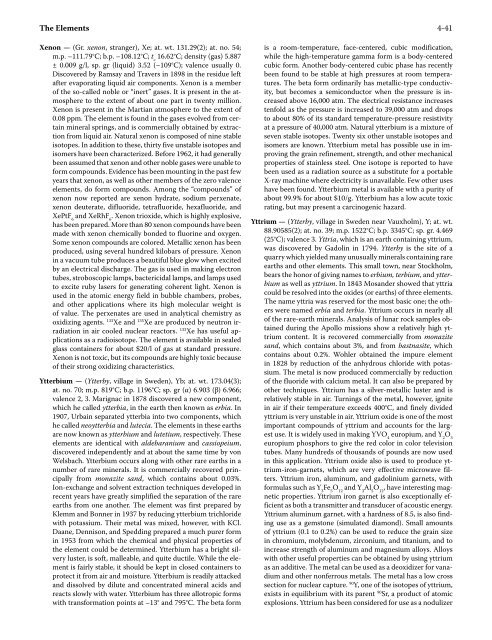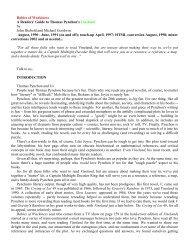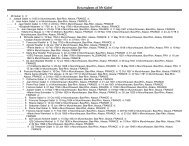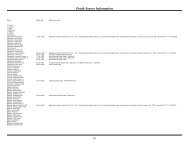CRC Handbook of Chemistry and Physics, 86th Edition
CRC Handbook of Chemistry and Physics, 86th Edition
CRC Handbook of Chemistry and Physics, 86th Edition
You also want an ePaper? Increase the reach of your titles
YUMPU automatically turns print PDFs into web optimized ePapers that Google loves.
The Elements 4-41<br />
Xenon — (Gr. xenon, stranger), Xe; at. wt. 131.29(2); at. no. 54;<br />
m.p. –111.79°C; b.p. –108.12°C; t c 16.62°C; density (gas) 5.887<br />
± 0.009 g/l, sp. gr (liquid) 3.52 (–109°C); valence usually 0.<br />
Discovered by Ramsay <strong>and</strong> Travers in 1898 in the residue left<br />
after evaporating liquid air components. Xenon is a member<br />
<strong>of</strong> the so-called noble or “inert” gases. It is present in the atmosphere<br />
to the extent <strong>of</strong> about one part in twenty million.<br />
Xenon is present in the Martian atmosphere to the extent <strong>of</strong><br />
0.08 ppm. The element is found in the gases evolved from certain<br />
mineral springs, <strong>and</strong> is commercially obtained by extraction<br />
from liquid air. Natural xenon is composed <strong>of</strong> nine stable<br />
isotopes. In addition to these, thirty five unstable isotopes <strong>and</strong><br />
isomers have been characterized. Before 1962, it had generally<br />
been assumed that xenon <strong>and</strong> other noble gases were unable to<br />
form compounds. Evidence has been mounting in the past few<br />
years that xenon, as well as other members <strong>of</strong> the zero valence<br />
elements, do form compounds. Among the “compounds” <strong>of</strong><br />
xenon now reported are xenon hydrate, sodium perxenate,<br />
xenon deuterate, difluoride, tetrafluoride, hexafluoride, <strong>and</strong><br />
XePtF 6 <strong>and</strong> XeRhF 6 . Xenon trioxide, which is highly explosive,<br />
has been prepared. More than 80 xenon compounds have been<br />
made with xenon chemically bonded to fluorine <strong>and</strong> oxygen.<br />
Some xenon compounds are colored. Metallic xenon has been<br />
produced, using several hundred kilobars <strong>of</strong> pressure. Xenon<br />
in a vacuum tube produces a beautiful blue glow when excited<br />
by an electrical discharge. The gas is used in making electron<br />
tubes, stroboscopic lamps, bactericidal lamps, <strong>and</strong> lamps used<br />
to excite ruby lasers for generating coherent light. Xenon is<br />
used in the atomic energy field in bubble chambers, probes,<br />
<strong>and</strong> other applications where its high molecular weight is<br />
<strong>of</strong> value. The perxenates are used in analytical chemistry as<br />
oxidizing agents. 133 Xe <strong>and</strong> 135 Xe are produced by neutron irradiation<br />
in air cooled nuclear reactors. 133 Xe has useful applications<br />
as a radioisotope. The element is available in sealed<br />
glass containers for about $20/l <strong>of</strong> gas at st<strong>and</strong>ard pressure.<br />
Xenon is not toxic, but its compounds are highly toxic because<br />
<strong>of</strong> their strong oxidizing characteristics.<br />
Ytterbium — (Ytterby, village in Sweden), Yb; at. wt. 173.04(3);<br />
at. no. 70; m.p. 819°C; b.p. 1196°C; sp. gr (α) 6.903 (β) 6.966;<br />
valence 2, 3. Marignac in 1878 discovered a new component,<br />
which he called ytterbia, in the earth then known as erbia. In<br />
1907, Urbain separated ytterbia into two components, which<br />
he called neoytterbia <strong>and</strong> lutecia. The elements in these earths<br />
are now known as ytterbium <strong>and</strong> lutetium, respectively. These<br />
elements are identical with aldebaranium <strong>and</strong> cassiopeium,<br />
discovered independently <strong>and</strong> at about the same time by von<br />
Welsbach. Ytterbium occurs along with other rare earths in a<br />
number <strong>of</strong> rare minerals. It is commercially recovered principally<br />
from monazite s<strong>and</strong>, which contains about 0.03%.<br />
Ion-exchange <strong>and</strong> solvent extraction techniques developed in<br />
recent years have greatly simplified the separation <strong>of</strong> the rare<br />
earths from one another. The element was first prepared by<br />
Klemm <strong>and</strong> Bonner in 1937 by reducing ytterbium trichloride<br />
with potassium. Their metal was mixed, however, with KCl.<br />
Daane, Dennison, <strong>and</strong> Spedding prepared a much purer form<br />
in 1953 from which the chemical <strong>and</strong> physical properties <strong>of</strong><br />
the element could be determined. Ytterbium has a bright silvery<br />
luster, is s<strong>of</strong>t, malleable, <strong>and</strong> quite ductile. While the element<br />
is fairly stable, it should be kept in closed containers to<br />
protect it from air <strong>and</strong> moisture. Ytterbium is readily attacked<br />
<strong>and</strong> dissolved by dilute <strong>and</strong> concentrated mineral acids <strong>and</strong><br />
reacts slowly with water. Ytterbium has three allotropic forms<br />
with transformation points at –13° <strong>and</strong> 795°C. The beta form<br />
is a room-temperature, face-centered, cubic modification,<br />
while the high-temperature gamma form is a body-centered<br />
cubic form. Another body-centered cubic phase has recently<br />
been found to be stable at high pressures at room temperatures.<br />
The beta form ordinarily has metallic-type conductivity,<br />
but becomes a semiconductor when the pressure is increased<br />
above 16,000 atm. The electrical resistance increases<br />
tenfold as the pressure is increased to 39,000 atm <strong>and</strong> drops<br />
to about 80% <strong>of</strong> its st<strong>and</strong>ard temperature-pressure resistivity<br />
at a pressure <strong>of</strong> 40,000 atm. Natural ytterbium is a mixture <strong>of</strong><br />
seven stable isotopes. Twenty six other unstable isotopes <strong>and</strong><br />
isomers are known. Ytterbium metal has possible use in improving<br />
the grain refinement, strength, <strong>and</strong> other mechanical<br />
properties <strong>of</strong> stainless steel. One isotope is reported to have<br />
been used as a radiation source as a substitute for a portable<br />
X-ray machine where electricity is unavailable. Few other uses<br />
have been found. Ytterbium metal is available with a purity <strong>of</strong><br />
about 99.9% for about $10/g. Ytterbium has a low acute toxic<br />
rating, but may present a carcinogenic hazard.<br />
Yttrium — (Ytterby, village in Sweden near Vauxholm), Y; at. wt.<br />
88.90585(2); at. no. 39; m.p. 1522°C; b.p. 3345°C; sp. gr. 4.469<br />
(25°C); valence 3. Yttria, which is an earth containing yttrium,<br />
was discovered by Gadolin in 1794. Ytterby is the site <strong>of</strong> a<br />
quarry which yielded many unusually minerals containing rare<br />
earths <strong>and</strong> other elements. This small town, near Stockholm,<br />
bears the honor <strong>of</strong> giving names to erbium, terbium, <strong>and</strong> ytterbium<br />
as well as yttrium. In 1843 Mos<strong>and</strong>er showed that yttria<br />
could be resolved into the oxides (or earths) <strong>of</strong> three elements.<br />
The name yttria was reserved for the most basic one; the others<br />
were named erbia <strong>and</strong> terbia. Yttrium occurs in nearly all<br />
<strong>of</strong> the rare-earth minerals. Analysis <strong>of</strong> lunar rock samples obtained<br />
during the Apollo missions show a relatively high yttrium<br />
content. It is recovered commercially from monazite<br />
s<strong>and</strong>, which contains about 3%, <strong>and</strong> from bastnasite, which<br />
contains about 0.2%. Wohler obtained the impure element<br />
in 1828 by reduction <strong>of</strong> the anhydrous chloride with potassium.<br />
The metal is now produced commercially by reduction<br />
<strong>of</strong> the fluoride with calcium metal. It can also be prepared by<br />
other techniques. Yttrium has a silver-metallic luster <strong>and</strong> is<br />
relatively stable in air. Turnings <strong>of</strong> the metal, however, ignite<br />
in air if their temperature exceeds 400°C, <strong>and</strong> finely divided<br />
yttrium is very unstable in air. Yttrium oxide is one <strong>of</strong> the most<br />
important compounds <strong>of</strong> yttrium <strong>and</strong> accounts for the largest<br />
use. It is widely used in making YVO 4 europium, <strong>and</strong> Y 2 O 3<br />
europium phosphors to give the red color in color television<br />
tubes. Many hundreds <strong>of</strong> thous<strong>and</strong>s <strong>of</strong> pounds are now used<br />
in this application. Yttrium oxide also is used to produce yttrium-iron-garnets,<br />
which are very effective microwave filters.<br />
Yttrium iron, aluminum, <strong>and</strong> gadolinium garnets, with<br />
formulas such as Y 3 Fe 5 O 12 <strong>and</strong> Y 3 Al 5 O 12 , have interesting magnetic<br />
properties. Yttrium iron garnet is also exceptionally efficient<br />
as both a transmitter <strong>and</strong> transducer <strong>of</strong> acoustic energy.<br />
Yttrium aluminum garnet, with a hardness <strong>of</strong> 8.5, is also finding<br />
use as a gemstone (simulated diamond). Small amounts<br />
<strong>of</strong> yttrium (0.1 to 0.2%) can be used to reduce the grain size<br />
in chromium, molybdenum, zirconium, <strong>and</strong> titanium, <strong>and</strong> to<br />
increase strength <strong>of</strong> aluminum <strong>and</strong> magnesium alloys. Alloys<br />
with other useful properties can be obtained by using yttrium<br />
as an additive. The metal can be used as a deoxidizer for vanadium<br />
<strong>and</strong> other nonferrous metals. The metal has a low cross<br />
section for nuclear capture. 90 Y, one <strong>of</strong> the isotopes <strong>of</strong> yttrium,<br />
exists in equilibrium with its parent 90 Sr, a product <strong>of</strong> atomic<br />
explosions. Yttrium has been considered for use as a nodulizer







